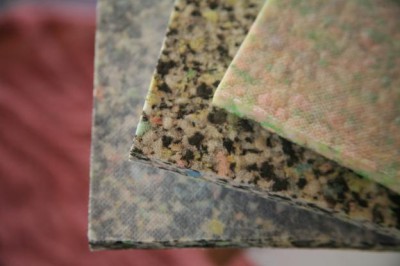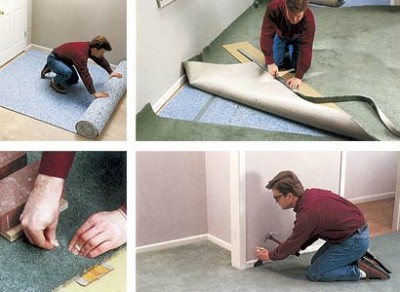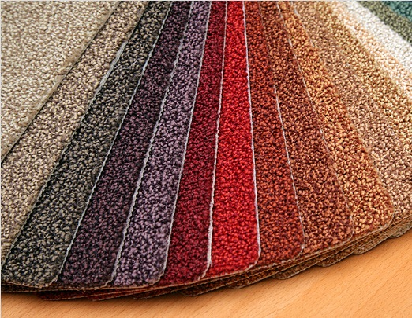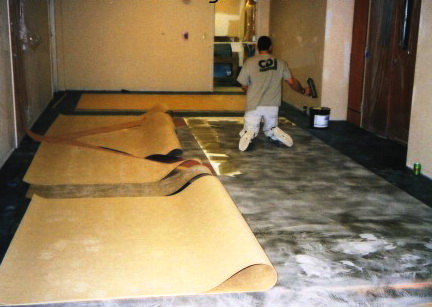How to lay a carpet - an overview of methods and technology for performing work
The process of acquiring carpet and flour regarding the choice of a particular type of carpet is finally left behind. Before the interior was transformed, there was only one last step left - laying the carpet. In a small size room, the coating can be laid on its own, but if you are not sure of your competence, it is better to entrust this issue to specialists. Ready to take a chance? So you will be curious to know how to lay the carpet correctly.
All work on laying the carpet should be carried out at a temperature of 15-25 degrees. Relative humidity should not exceed 75 percent.
Remember! The greatest load always lies on the floor - therefore, in the process of forming a quality coating under your feet, try not to save either money or effort. From how successfully and correctly the installation work will be carried out, both the durability and the presentability of the material you have chosen will depend.
What to lay under the carpet?
You probably want the carpet to serve you faithfully for more than one year? Then we advise you to be prudent - maybe you should think (before it's too late) about the substrate for the carpet. Experts recommend using it to increase the life of the coating, as well as to maintain its attractive appearance.
Using such an additional gasket gives you a lot of advantages, because it is capable of:
- increase the elasticity of the carpet;
- to bring to a new level indicators of noise and heat insulation;
- increase comfort under your feet;
- increase the life of the carpet by at least one and a half times.
When walking, the substrate takes on part of the impact, thereby demonstrating its shock-absorbing properties.
Without it, the carpet will fray much faster between the harsh base and shoes.
Interesting! Using the substrate, you can “crank” one little trick - laying a thin carpet on top of it can achieve a plausible effect of a thick high-pitched coating.
The materials from which the “auxiliary layer” is made can be quite diverse - this is corrugated rubber, and synthetic felt, polyurethane foam, etc.
Important! The main requirement for the substrate under the carpet - it should be sufficiently elastic. How to check it? Do a mini experiment - squeeze the backing. Easily crumpled? So it does not fit!
How to lay a carpet: an overview of the main ways
The choice of method for laying carpet directly depends on:
- the nature of the base (whether a substrate is present);
- the degree of patency of the room;
- functional purpose of the room;
- general condition of the sexes.
Consider the methods of forming a floor covering from carpet, which are most often used by ordinary people.
Free laying - perimeter fixation
This option is the most budgetary: after all, it does not require expenses on the substrate, adhesive tape, adhesive for carpet.
Technology
Carpet is unfolded with an allowance for walls (about 5 cm), using a conventional roller it is smoothed in the direction from the center of the room to the walls. V-shaped cuts are made in the corners, all excesses are also eliminated. The carpet is fixed using metal battens and baseboards.
Free laying - fixing on adhesive tape
The width of the tape is selected depending on the type of carpet (63-150 millimeters).
Technology
First, double-sided tape is glued around the perimeter of the room. Then they begin to form a grid from it: the optimal cell size is 50 × 50 centimeters.
Note! The upper protective layer is not removed at this stage.
Cut with a ten-centimeter reserve, the carpet is laid on the floor surface. Now you can remove the tape from the tape and stick the coating.
Excesses are removed with a special knife.
Interesting! A ten-meter roll of adhesive tape is usually enough for a small room with an area of about 8 square meters.
Glue laying
It is possible only in cases where the rough base is concrete (including leveled with a mixture) or wooden.
Important! Are you planning to lay carpet on linoleum or laminate? Glue laying is excluded in this case.
Technology
The glue is applied to half the surface of the floor and leveled with a spatula. A fragment of a carpet of a given size is laid on a mixture that has not yet dried. Then the coating should be leveled. The same goes for the second half.
Overlock
In those rare cases when the carpet does not need special fixation (operation of the coating on the loggia or balcony), it is permissible to treat the edges of the material using the overlock method (using a thread that prevents “drying out”). This mat is easy to remove and clean.
Stretching as the most progressive way
Using a backing is required.
Technology
Grippers are fastened around the perimeter of the room - a carpet is fixed on them by tension. The advantages of this method are the absence of the need to prepare the base, increase the life of the carpet, the coating is easy to replace.
How to lay a carpet - video: secrets from professionals
Having fixed the theoretical information with useful video instruction, you can proceed to do it yourself.






2 comments